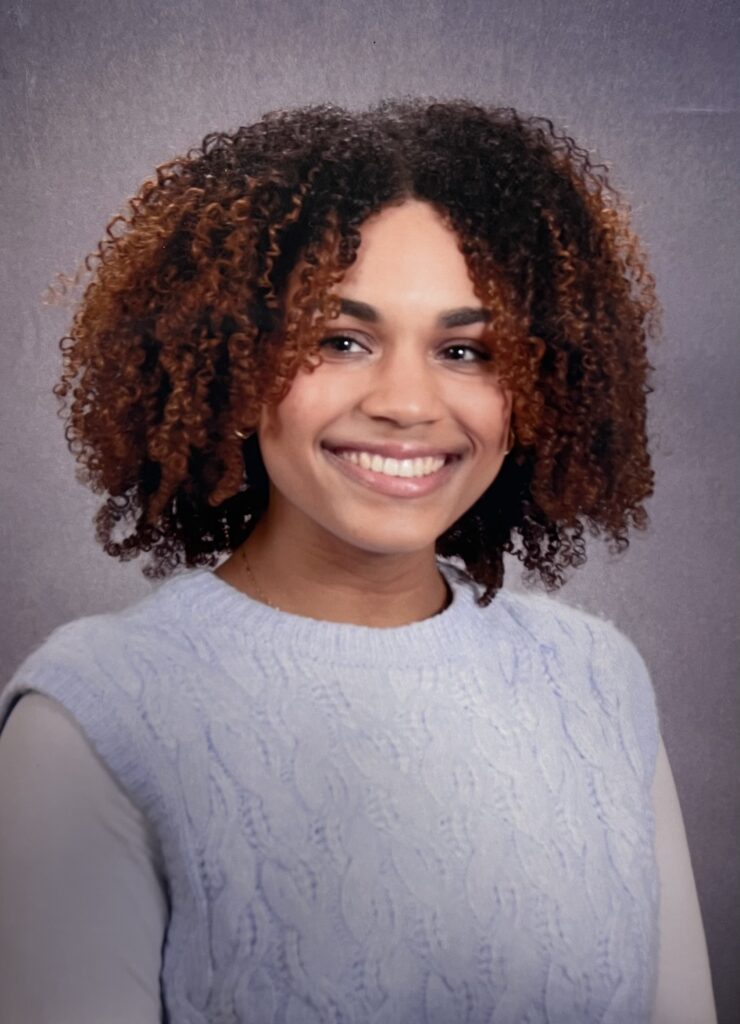The two newest Alma Exley Scholars offered a master class in the importance and impact of teachers of color when they were introduced at a virtual event recently.
Alexus Lee, a master’s degree student at the University of Bridgeport, and Soribel Torres-Jiménez, a senior at UConn, were honored at the 27th annual celebration of the Alma Exley Scholarship Program, whose mission is to increase diversity in the educator workforce. More than 40 educators and supporters of the program attended the celebration held via Zoom.
Ms. Lee and Ms. Torres-Jiménez thanked the program for their scholarships and shared insights into the issue of educator diversity based on their own experiences as students and aspiring teachers.

Alexus Lee
Positive Role Models
Ms. Lee said, in part:
“When I started college, I became a camp counselor at LEAP (Leadership Education and Athletics Partnership), where I helped educate predominantly Black children. This was one of the greatest experiences for me because, for the first time ever, I was around educators who looked like me. They spoke like me and dressed like me. But most important, they resembled the kids.
“So many of these children found positive role models to look up to. Many of them found father and older brother figures to push them to become their best selves. This is extremely important for all students, but especially the minority kids because they may not have these role models at home. I truly believe that students develop a stronger connection and level of trust when they genuinely believe the teacher can understand them because of shared experiences.
The Only Black Teacher
“This school year, I began interning in a school that is predominantly white. I have counted six Black students across all five grades, and there are no Black teachers. Being the only black teacher in the beginning of the school year was hard. When I changed my hair from long extensions to my Afro for the first time, I received comments from the students such as, ‘Why did you cut your hair? It looked better before.’ And, ‘Your hair isn’t supposed to look like that. It should be straight like mine.’
“I’ll admit, these questions and comments were hurtful because I’d never experienced something like this before. And the teachers were just as confused. At first, I felt as though I did not belong in this community. I wanted so badly to go back to LEAP where everyone looked like me.
Explaining the Afro
“Then one moment changed my entire view. This was when I first wore my Afro at my internship class. One of the teachers asked me why I choose to wear my hair like this so often. I was explaining to him that this is how my hair naturally grows, just as his grows straight. Then I looked up and realized there were four other teachers around me eagerly waiting for my response as well.
“At this moment, I realized how important it is to have Black teachers. These students and educators have so many questions about Black people because they have not been around us. They’re not used to us.
“Now, after eight months of teaching here, it’s less common for teachers or students to ask why I ‘cut my hair’ when I go from extensions to my Afro. Most times, they don’t comment at all because they’ve grown more used to me. Students feel comfortable asking me about my skin and my hair now.
“This extends to the Black students in the school as well. Recently, one of them eagerly ran up to me in the hallway. He had the biggest smile and said, ‘Hey! Your hair looks like mine!’ We continued talking because he wanted to know more about how he can take care of it like I do.
Impact on White Students
“The white students in my internship are asking questions because they are genuinely curious, and I am the only one who can teach them about people who look different from them. I can help them understand more about the world they live in. As for the six Black students, they can feel more comfortable in their skin and with their kinky hair knowing that there is a teacher in the building who will always stand up for them.
“In conclusion, Black teachers are so important…in any school. It is important that young Black students see older Black people with good jobs, but it’s also important to expose white students to diversity. It is rare for someone to be around only people who look like them. By answering the children’s questions now, they will be more comfortable around those who look different from them in the future. And that’s why I think it’s so important to have Black teachers in the classroom.”

Soribel Torres-Jiménez
More Educators of Color Are Needed
Ms. Torres-Jiménez said, in part:
“Being a future teacher of color is hard, but worth it. Our education system is doing all students a disservice when there is no representation by educators of color in the education system itself.
“I was born and raised in Waterbury, Connecticut, which is a very diverse community. However, I recall having only three teachers of color from elementary school through high school. Only two of those teachers spoke Spanish.
“My first teacher of color was in third grade, and I had the privilege of having her in fifth grade too. She contributed to the beginning of my passion to become a teacher, specifically for English language learners in urban settings. I was a first-generation college student, and my parents were very unfamiliar with the American school system. They are immigrants from the Dominican Republic and valued the education and opportunities the United States offered my siblings and me.
Language Barrier
“From parent-teacher conferences to science fairs, there was a language barrier which made it difficult for my parents to understand my successes and where I needed more support in school. There is this negative perspective targeted toward minority parents that they ‘do not care’ about their child’s progress and do not find the need to be involved in their studies. In reality, there are reasons why many parents cannot attend school events because of rigorous work schedules, divorced families, limited transportation, language barriers, etc.
“My first teacher of color understood that my family was not any less interested than other families that seemed more involved. She was able to communicate with my parents in Spanish, send home translated information, and even include more cultural awareness in the classroom.
“I no longer felt like an outsider or as if my parents weren’t enough. This teacher allowed me to embrace my identities and she would also share her relatable anecdotes with the class to normalize more than one culture in the classroom.”
Celebrating All Student Backgrounds
“As an educator, you must be able to create environments that support and celebrate all student backgrounds. The classroom is a space that does not highlight one’s deficits; instead, it caters to the student’s strengths. I want to be a future educator that can step in and make all families and cultures feel involved in their child’s education.
“These positions of power need people of color to bring in socially just practices, representation, equity, and love. It’s also important for white students to have teachers of color. In order to dismantle systemic racism and injustices, it’s important for white students to see people of color holding many leadership positions.”
-0-
